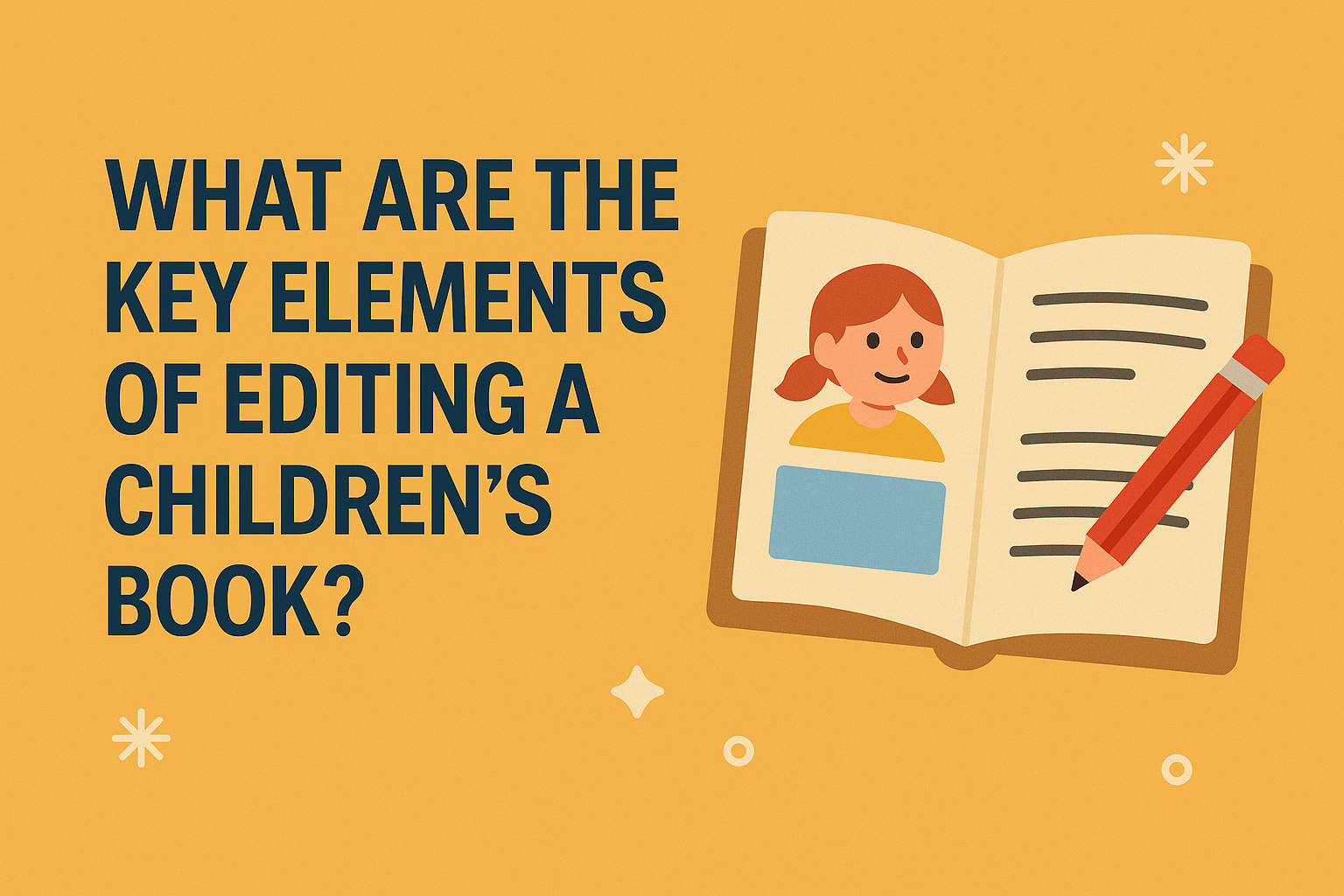What Are the Key Elements of Editing a Children’s Book?

Introduction to Children’s Book Editing
Children’s book editing is a delicate yet powerful process. It’s not just about fixing typos—it’s about shaping a story that resonates with young readers while meeting the developmental, emotional, and entertainment needs of its audience. Whether you’re writing a picture book or a middle-grade novel, understanding the nuances of Children’s Book Editing is crucial for success.
Understanding the Children’s Book Market
Age Groups and Developmental Stages
Children’s books target specific age groups: babies (0–2), toddlers (2–4), preschool (4–6), early readers (6–8), and middle grade (8–12). Each group has unique cognitive and emotional needs, which editors must consider when reviewing tone, vocabulary, and content.
Trends and Reader Expectations
Today’s readers—and their parents—expect engaging, educational, and diverse content. Editors must stay updated with trends, such as STEM themes, mental health representation, and diversity, to ensure books remain competitive and relevant.
Core Components of Children’s Book Editing
Story Structure and Plot Clarity
A well-structured story includes a clear beginning, middle, and end. Children need simple yet engaging plots. Editors evaluate pacing, plot progression, and story arc to ensure coherence and excitement.
Character Consistency and Development
Strong, relatable characters are a must. Editors check for character motivations, growth, and consistency throughout the book to make sure children can connect with them.
Dialogue That Resonates
Kids appreciate dialogue that feels authentic. Editors ensure characters speak in age-appropriate ways while keeping the dialogue lively and true to their personality.
Language and Readability
Vocabulary Choice for Different Ages
Editing for vocabulary means selecting words that challenge but don’t overwhelm. Younger children benefit from repetition and simple words, while older readers can handle more complexity.
Sentence Length and Simplicity
Short, direct sentences improve comprehension and maintain rhythm. Editors break up long sentences and remove unnecessary complexity.
Maintaining Rhythm and Flow
Children’s books often use rhythm and rhyme. Editors ensure the manuscript flows naturally when read aloud, which enhances enjoyment and understanding.
Visual Considerations in Editing
Text-Image Synergy
For picture books, the text must complement illustrations. Editors adjust narratives to leave room for visuals, avoiding redundant descriptions.
Page Layout and Formatting Tips
Editors consider where the text appears on a page, aligning it with page turns and illustrations to maximize impact.
Illustration Cues in Manuscripts
Manuscripts often include art notes. Editors check that these are clear and necessary, avoiding over-directing the illustrator.
Tone, Voice, and Theme Consistency
Appropriate Tone for the Audience
The tone must match the emotional and intellectual level of the target age group—whether humorous, serious, or imaginative.
Consistency in Narrative Voice
A consistent voice builds trust and engagement. Editors ensure narrators don’t shift tone or vocabulary erratically.
Alignment With Moral or Educational Themes
Editors look for subtle, non-preachy lessons and consistent thematic development that supports a book’s educational or moral intent.
Grammar, Spelling, and Punctuation
Common Errors in Children’s Manuscripts
Frequent issues include misused homophones and inconsistent tense. Editors ensure clarity without compromising style.
Style Guide Adherence
Whether following Chicago Manual of Style or publisher-specific guidelines, consistency is key.
Spelling Variations
Editors ensure consistency in regional spelling—especially when targeting international markets (e.g., US vs. UK English).
Sensitivity and Inclusivity in Editing
Age-Appropriate Topics
Editors must flag content that may be too complex or frightening. They balance storytelling freedom with age sensitivity.
Inclusive and Diverse Representation
Children’s books should reflect the diversity of their readers. Editors assess characters, settings, and dialogue for bias and stereotypes.
Ethical Storytelling
Editing includes checking for consent in interactions, appropriate resolutions to conflict, and messages that empower young readers.
Editing for Read-Aloud Quality
Readability When Spoken
Many children’s books are read aloud. Editors evaluate how sentences sound when spoken and tweak awkward phrasing.
Rhythm and Repetition
Repetition helps retention. Editors assess whether repetition is used effectively or excessively.
Sound and Phonetics
Some words are hard to pronounce aloud. Editors adjust language for smoother phonetics and reader comfort.
Beta Readers and Child Test Groups
Value of Young Readers’ Feedback
Real kids offer insights that adults might miss. Editors use this feedback to gauge engagement and comprehension.
Analyzing Feedback Effectively
Editors interpret whether feedback reflects a misunderstanding, a content issue, or an illustration gap.
Applying Feedback Wisely
Not all feedback requires change, but editors use trends in responses to guide revisions.
The Different Levels of Children’s Book Editing
Developmental Editing
This focuses on story structure, pacing, and themes. It’s the “big picture” review.
Copyediting
This level handles grammar, consistency, and sentence structure.
Proofreading
The final pass fixes typos, punctuation, and formatting issues before publication.
Working With a Professional Children’s Book Editor
Finding the Right Fit
Editors should have experience in your genre and age category. Referrals and portfolios help.
The Editing Process
Expect multiple rounds, feedback sessions, and collaborative discussion.
Cost and Timeline
Rates vary. Developmental editing is often the most expensive, with longer turnaround times.
Self-Editing Techniques for Authors
- Read aloud to spot awkward phrasing
- Use tools like Grammarly or ProWritingAid
- Track changes and version history
- Take breaks to return with fresh eyes
The Role of Publishing Standards
Whether you’re self-publishing or going traditional, you’ll face:
- Submission guidelines
- Layout and print requirements
- Age-level expectations
Editors make sure your manuscript meets these benchmarks.
Common Pitfalls in Children’s Book Editing
- Using vocabulary too advanced
- Overexplaining simple concepts
- Forgetting the visual narrative
- Ignoring child feedback
FAQs About Children’s Book Editing
1. How is editing a children’s book different from adult books?
Children’s book editing requires an understanding of age-specific language, educational themes, and visual storytelling. It’s more concise and sensitive to developmental needs.
2. Do I need an editor if I’m self-publishing a children’s book?
Absolutely. An editor ensures your book is polished, age-appropriate, and market-ready—boosting its chances for success.
3. How much does children’s book editing cost?
Costs range from $300 to over $2,000, depending on word count, editing level, and editor experience.
4. Can AI tools replace professional children’s book editors?
While tools can assist with grammar, they can’t assess tone, developmental appropriateness, or visual integration like a human editor can.
5. How long does it take to edit a children’s book?
Timeframes vary, but developmental editing can take 2–4 weeks, with copyediting and proofreading requiring 1–2 weeks each.
Conclusion
Editing a children’s book is both a technical and artistic endeavor. From refining language to ensuring inclusivity, Children’s Book Editing plays a vital role in bringing stories to life in a way that connects with young readers. Whether you’re an aspiring author or a seasoned storyteller, investing time and care in the editing process can turn your manuscript into a memorable, magical book.











